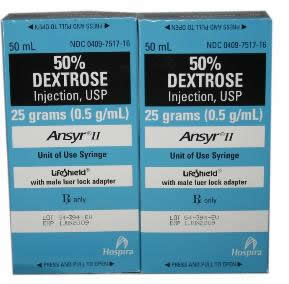More Drug Dose Calculations
Published (updated: ).

Let’s look at a medication we give every day, D50. D50 is Dextrose 50% in water (sterile for injection, of course). To make D50, you take 25 grams of dextrose and add it to 50cc’s of water.
Experiment: Make D25 out of D50
| Equipment Needed |
| 1- 50-60 cc syringe |
| 1- pre-filled syringe of D50 |
| 1- 19 g hypodermic needle |
| 1 – 250 or 1000 cc bag of NS |
Directions
Be sure to wear rubber gloves while you do this experiment. D50 is highly viscous and very sticky. It would also be a good idea to do this somewhere in the engine room or outside as this experiment tends to get very messy.
- Connect the hypodermic needle to the 50-60 cc syringe
- With the plunger removed from the D50 administration set, remove the plunger and insert the 50 cc syringe/hypodermic needle into the back of the administration set (be sure to decontaminate the back of the syringe).
- Aspirate 25 cc’s of the D50 solution into the 50-60 cc syringe
- Now aspirate 25 cc of NS from the IV bag (be sure to decontaminate the injection port)..
- Now do the math (you can use the calculator if you wish).
Decimals
A decimal point separates the whole number from the decimal fraction. Everything to the right of the whole number is a fraction (and a percent for that matter). Decimals can be rounded to the nearest tenth, hundredth, or even the nearest whole number.$0.25 is a fraction of a whole number. What you are saying is that you have 100 whole units and 0.25 of another whole unit. You could also say that you have 1/4 of a dollar or 25% of a dollar
Decimals are Really Just Fractions
Decimal notation is just a shorthand way of expressing certain fractions, namely those fractions with denominators that are powers of 10. For example, consider the number 2.345 Because of the place-values of the decimal digits, this really means

Converting Decimals to Fractions
Because all the denominators are powers of 10, it is very easy to add these fractions by finding a common denominator. In this example, the common denominator is 1000, and we get
This suggests a general rule for converting a decimal number to its fraction form:
- Put all the digits over the denominator that corresponds to the last decimal place value.
In the number 2.345, the last decimal place value is the thousandths place, so we put the digits 2345 over the denominator 1000.
Of course we would usually want to reduce the resulting fraction to its simplest form. In this case![]()
Repeating Fractions
The only time this method does not work is for repeating fractions. We know that 1/3 = 0.3333333… but how could we go from 0.3333333… back to 1/3? There is no ‘last decimal place’ because the decimals repeat forever. Fortunately, there is a simple trick for this:
- Put the repeating digit over a denominator of 9. So we see that in the case of 0.3333333…., the repeating digit is 3, and we make the fraction 3/9, which reduces to 1/3. If there is a group of more than one digit that repeats
- Put the repeating group of digits over as many 9’s as there are digits.
- For example, in the fraction

we see that the group of digits ‘15’ repeats, so we put ‘15’ over a denominator of ‘99’ to get
- One warning: This only works for the repeating fraction part of a number. If you have a number like 2.33333…, you should just work with the decimal part and rejoin it with the whole part after you have converted it to a fraction.
- Irrational numbers like p or
 have non-repeating decimals, and so they cannot be written as fractions. You can, however, round them off at some point and produce an approximate fraction for them.
have non-repeating decimals, and so they cannot be written as fractions. You can, however, round them off at some point and produce an approximate fraction for them.
Converting Fractions to Decimals
We know the decimal equivalents for some common fractions without having to think about it: 1/2 = 0.5, 3/4 = 0.75, etc. But how do we arrive at these numbers? Remember that the fraction bar means the same thing as division.
- To convert a fraction to a decimal, do the division.
For example,![]()
You can do the division with a calculator or by hand with long division.
